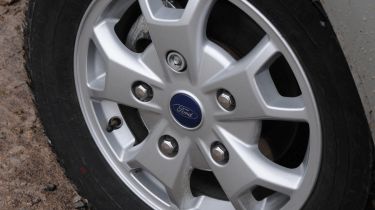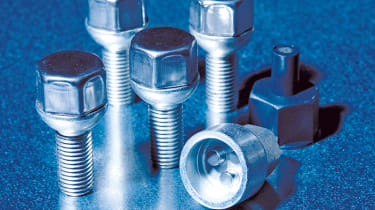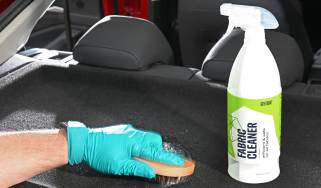Locking wheel nuts explained: types, removal and lost keys
We explain how locking wheel nuts work, and what to do when you lose your locking wheel nut key…

Alloy wheels are fitted to cars of all shapes and sizes these days; from small superminis and family hatchbacks to luxury SUVs – but no matter the vehicle, car wheels are a prime target for criminals. One way car manufacturers have combated wheel thefts is through the use of locking wheel nuts (also known as lug nuts or alloy wheel nuts).
Locking wheel nuts do not have standard hexagonal heads like a normal nut and bolt. They require a unique locking wheel nut ‘key’ to remove them. This guide looks at the different types of locking wheel nuts, what to do if they become damaged and how you can remove a locking wheel nut if you lose the key.
What are locking wheel nuts?
If your car has alloy wheels, chances are locking wheel nuts may have been fitted as standard by the manufacturer. There are four locking wheel nuts in a set, and they come with a single matching ‘key’, which is a specially shaped socket designed to fit the supposedly unique pattern of your locking wheel nuts. In fact, there are a limited number of patterns used by individual manufacturers, so other drivers will have keys that match your wheel nuts too.
If your car doesn’t come with a locking wheel nut, you can easily buy them as a set from the manufacturer, car accessory stores or online retailers.
You only need to use one locking nut on each wheel, where it simply replaces one of the regular wheel nuts. Fitting locking wheel nuts is easy, and they provide an excellent deterrent against opportunistic theft. In fact, as a result of locking wheel nuts being widely fitted, car wheel theft has become pretty rare. However, the bad news is that wheel theft from premium cars could be on the rise again, in spite of widespread use of locking wheel nuts. That’s because, given the right equipment and a few minutes work, committed criminals can overcome most of the challenges the different types of locking wheel nuts present.
Alloy wheels are becoming ever more extravagant and expensive, and one of the factors influencing an increasing incidence of wheel theft could be Personal Contract Purchase (PCP) schemes. That’s because anyone who damages wheels on a car they’re driving on a PCP will find themselves liable for refurbishment and replacement costs that could run into thousands of pounds when they’re due to return their car. In which case, it’s easy to see how people might be tempted to ask no questions when offered a cheap ‘second hand’ wheel replacement via an internet ad.
Theft aside, as with most forms of car security, problems often start for the locking wheel nut owner when you lose or damage the key. To make matters worse, you may not realise you’ve lost your wheel nut key until you need it - perhaps leaving you stranded at the side of the road with a punctured tyre on a wheel you can’t remove. Fortunately, removing a locking wheel nut without the key is relatively easy for breakdown services, professional tyre fitters and mechanics with the right equipment and can be done without damage to the alloys.
If you’ve lost your locking wheel nut, you could attempt to remove it yourself using a locking wheel nut removal tool which can be picked up from an accessory shop or online. We would urge against doing this yourself, as you may need professional tools to do the job successfully. It’s also very easy to damage your wheels and the locking wheel nut itself, making the removal even more difficult. This could end up costing you more to rectify the issue than it would have if you called a professional in the first place.

What are the main types of locking wheel nut?
There are three main types of locking wheel nuts. The simplest and most popular is a keyed head on your wheel nut that requires a matching socket to undo it.
Next are the type of locking wheel nuts with a rotating collar around the nut, designed to make it impossible to get purchase on the nut without the key.
Finally, on cars that use removable wheel bolts instead of nuts, you find bolts with heads that are designed to shear off if you don’t have the proper removal key.
Where is my locking wheel nut kept?
If you haven’t used your locking wheel nut since you purchased your car, chances are your locking wheel nut is where the manufacturer of the vehicle stored it, but that could be a few different places:
- The glove box: some manufacturers will store the locking wheel nut in the vehicle’s glovebox, so checking here would be a good place to start.
- Under the boot floor: if your car has a spare wheel, the locking wheel nut could be located in a compartment with the spare wheel under the boot floor. If your car didn’t come with a spare tyre but does include a tyre repair kit, the wheel nut key could also be stored here.
- In the boot: some cars come with storage compartments in the sides of the boot, often used for spare bulbs and storing the locking wheel nut. If your car has boot storage compartments, it’s a good idea to check here, too.
- Check under the seats or in the door bins. If you’ve checked all the places mentioned above but to no avail, it’s worth checking under the seats, in the driver and passenger’s seat pockets, or in the door bins. The key could have ended up there.
If you bought a used car and can’t find the locking wheel nut in any of these places, the previous owner may have lost the locking wheel nut and forgot to inform you or the dealership when the car was sold. Thankfully, removing a locking wheel nut without the locking wheel nut key is fairly straightforward for tyre shops, breakdown services or a DIY-er if you have the right tools.
How to remove a locking wheel nut without the key
There are universal DIY tools available to remove locking wheel nuts without a key, but using a locking wheel nut remover requires a certain amount of confidence and they don’t always work.
For example, Halfords sells a special socket designed with a reverse thread on the inside that bites into your wheel nut and grips it hard enough for you to undo it. Many people have used them successfully, but even Halfords advises the tool should be used with a compressed air hammer for best results, and most people don’t have that sort of equipment at home. If you opt to use one of these universal keys, you could also easily end up damaging your alloy wheel while also making the locking wheel nut more difficult to remove.
The other favoured option when dealing with a lost key or damaged locking wheel nut is to drill out the offending wheel nut. Again this can be done by a competent DIY-er with the right equipment, but most people find it far easier to get the job done by professional mechanics at the garage.
Most garages will have the knowledge and equipment needed to remove a locking wheel nut. There is no universal cost for the removal of a locking wheel nut without the key. Most places will charge for this service at an hourly rate, so you could reasonably expect a bill of no more than half an hour’s labour per wheel. Expect this cost to be higher if you damage the locking wheel nut or your alloys by trying to remove the locking wheel nut at home beforehand.

How to replace your locking wheel nut key
If you’ve lost your locking wheel nut key or you discover the locking wheel nut key is damaged, the first thing you can do is order a new one from your local dealer, which is fairly simple. You’ll need a security code which is often located in either the car’s handbook, printed on the locking wheel nut box or bag (if your car came with one) or printed on a separate card along with your car’s radio code.
If you can’t find the key or your locking wheel nut key code, there are firms who will match your key pattern from a phone picture you send in showing the shape of your wheel nut. Each manufacturer will have a limited number of patterns, so finding the correct one which matches your locking wheel nut shouldn’t take too long. In this case you’ll often have to supply evidence that you own the vehicle you’re trying to get a wheel off, which could also mean sending a photo of your V5C log book.
Now your wheel nuts are sorted, check out our latest tyre test...
Find a car with the experts








